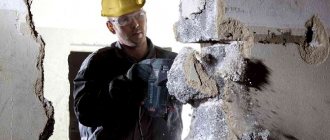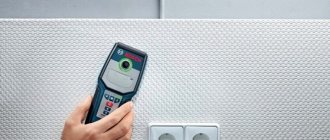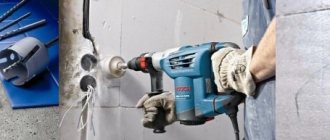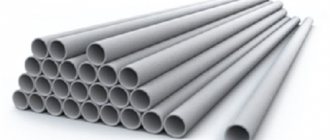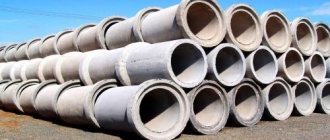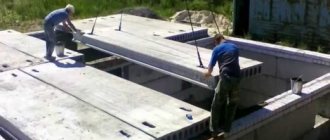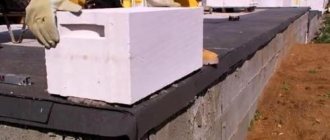How to drill a hole in the wall for a dowel?
The sequence is as follows:
- mark the centers of future holes;
- drill;
- remove dust from the hole using a construction vacuum cleaner or a rubber blower and brush;
- insert a dowel of the previously selected type;
- align the mounting holes on the item requiring installation with the fixation points;
27 Nov
2022 Interesting materials:
How to connect a Rostelecom box to a TV? How to connect a cursor on the keyboard? How to connect a light bulb to a plug? How to connect the left earphone to the right? How to connect any gamepad to PS4? How to connect Magic Trackpad to iPad? How to connect a melody instead of a beep on Beeline Kazakhstan? How to activate MTS international roaming while abroad? How to connect intercity to Beeline? How to connect Mi Band 3 to iPhone?
Performing work of increased complexity
Particular care should be taken when cutting holes for communications when working with complex materials, such as tiles. Due to the sufficient fragility of this material, it cannot be drilled in impact mode.
If you need to make a hole large enough, you will need to know some techniques:
- to work with such materials, you need special diamond bits, which are used for drilling at low speeds;
- to drill a hole, you may need a device such as a ballerina;
- To avoid the diamond bit or ballerina slipping off a smooth, hard-glazed surface at the work site, it is advisable to first scrape off the glossy layer a little with a file, or stick on masking tape so as not to damage the rest of the tile.
However, there is an alternative way to work with tiled flooring. Although it is cheaper, the risk of damaging the material is much higher. In this case, several holes are made around the circumference in the surface of the tile using a 3-4 mm drill. The areas between the holes begin to be carefully broken with a well-sharpened chisel and hammer, thus forming a hole. To obtain the exact size of the hole, the edges of the tile are trimmed with the same chisel.
Expert advice
If, while working with a pobedite bit, you accidentally stumble upon reinforcing bars, you can drill them out using a simple nozzle, but stones can be quickly broken up with a punch. A hole in a concrete wall can be created using a homemade punch. It is mounted from a special nozzle with a total diameter of 0.8 centimeters. The end of such a nozzle is ground to give it the shape of a swallow's tail. When creating a hole, the punch is held in the hand and hit with a hammer.
To significantly extend the life of the crown, it must be moistened with water from time to time during use.
Sometimes there are cases when crumbled material flies straight into a person’s eyes. At this time, you can make a special crown on the punch or a bolt. If there is a need to strengthen a screw into a concrete surface, then the following procedure will come to the rescue. You should place a small piece of nylon in the hole and melt it right there, using a hot nail. After this you can screw in the screw. After the concrete hardens, the screw will hold tightly inside the wall.
If you urgently need a dowel, but it is not nearby, then you can get out of this situation by using a piece of aluminum or copper tube. The piece must be compressed to the required caliber and installed in the hole.
During any construction work, the need arises to create different types of holes. To carry out such manipulations, there is a large list of devices that will help you create holes comfortably and quickly in a wide variety of building materials.
Most residential multi-storey buildings are built from concrete structures. When inhabiting a room or making repairs, you have to make holes to solve various problems. A problem arises: what and how to drill concrete?
There are several options:
- chisel the wall manually and then seal the remaining space with mortar;
- use mechanical devices and cutting tools.
The first method is a thing of the past. Holes in the concrete structure are drilled using a special tool.
Drilling tool
If you're wondering what to use to drill into a brick wall, there are several options to consider to decide which one is right for you. The simplest method is mechanized, which involves the use of a hammer and a bolt. This work algorithm will not allow large-scale work to be completed, but if there is only one hole, this approach will be ideal.
A more technologically advanced method compared to manual drilling is the electromechanical method. Here you can’t do without a drill, or, at a minimum, or at a maximum, without a hammer drill. It is better if the drills and augers are new, then the work will go faster. But diamond drilling of brick walls is usually carried out by professionals. It usually does not produce dry dust, but the work area will still require cleaning. The thing is that diamond drilling is accompanied by cooling of the equipment with water. However, only specialists can cope with such a task.
Attention! If you plan to drill brick walls yourself using electric household tools, you need to not only mark the hole, but also core the future hole. This will prevent the drill from slipping.
Fastening to concrete using non-standard methods
Self-tapping screws for concrete without drilling are used when it is impossible to use the classic pair - a Pobedit drill/dowel. If the concrete is old, loose or too thin, it is necessary to drill a hole of small diameter (without using a hammer drill) and screw in a self-tapping screw of a special configuration (dowel).
Such screws are widely used in aerated concrete walls.
If the surface on the other hand is particularly strong, special nails for concrete are driven into it without drilling.
This fastener has been known for a long time under the name “steel dowels”. They are killed with a sharp single blow. No hole is required; retention occurs due to wedging of the monolith. For convenience and safety, you can use special devices. There is no particular aesthetics in such fasteners, but for technological installation it is a practical solution.
Carbide bit
Such equipment will differ from others in its drill with a diameter of 5 to 45 centimeters. But unfortunately, the characteristics of a simple hammer drill do not make it possible to install a crown larger than twenty-five centimeters. The reason lies in the very low power rating of the device. If you need to create holes of large diameter, then it is better to use another tool.
The larger device has a different shank shape. But there are also special adapters that help you use a larger bit size on instruments with a low power rating. However, you need to remember that this option is not profitable and safe in all cases due to the fact that the device can be seriously damaged after installing a large crown. And the process of drilling holes in concrete using this method can become unsafe.
The device also has disadvantages that significantly limit its functionality:
- Unable to drill through reinforcement. During a collision with metal, a carbide crown can quickly collapse. While thin metal can be easily drilled, thick reinforcement cannot be drilled.
- If a crown is used, the concrete can be drilled to a shallow depth. This figure will be significantly limited by the bowl. But there are times when using the device you can easily drill holes in fairly thick walls and pipes.
The point of drilling holes with a hole saw is to use the bit and pick alternately. After the device reaches the depth required for the crown, you need to hollow out a special core in the hole using a pick. After this, this procedure is repeated until the necessary drilling is completed.
But in this case, another difficulty may arise - the limited depth of immersion of the lance. This problem can be eliminated if you use a special crown extension correctly. It must be remembered that when drilling concrete walls, a large amount of dust will form around.
As a result, the drilling process will be long and difficult. Sometimes the best solution is to use a different type of tool . What other tools can you use?
Concrete cutting tool
The formation of holes in concrete structures is carried out using a specialized cutting tool:
Drill
A drill is a cutting device for making holes.
- cylindrical shank;
- working part with spiral grooves for chip removal;
- cutting part.
The specificity of the drill for concrete is the presence of carbide brazing. The strength properties of the latter allow it to withstand impact loads that destroy concrete.
The insert looks like a small rectangular plate placed across the cylindrical end of the tool.
The maximum diameter obtained with a Pobedit drill for concrete does not exceed 12 mm. Minimum – 4 mm. Drilling depth limited to 30
Borax (species)
The difference between a drill and a drill is the method of attachment. The tool has a shank made using the SDS (SDS+) fixation system, etc. The spiral grooves are smaller and spaced at smaller pitches. For production, special hardened tool steel is used.
The drill is equipped with a two- or four-sided cutting plate. The maximum diameter of the hole formed by the drill reaches 40 mm. Depth – up to 800
Read also: Car compressor does not turn on
Types of concrete drills:
- pass-through – drilling holes of various diameters;
- flat – used to form a shallow hole;
- spiral - for deep passages;
- screw, – deep drilling, the presence of spiral grooves for removing sludge;
- breaking – used for operations with dimensional products.
A subtype of drill is a crown for concrete.
Crown
It is a tubular product:
- removable or monolithic shank with a fixation system in the hammer drill;
- pilot drill;
- a working cylinder that determines the diameter of the hole being made;
- carbide brazing on the end part, a type of diamond coating.
Using a concrete crown can be used to:
- a hole in the concrete for an outlet;
- under the pipe;
- bundle of cables, etc.
Stages of work
The technical process of drilling in concrete consists of several stages:
- Preparatory.
- Concrete processing.
Preparatory activities
In addition to marking the drilling points, it is necessary to identify hidden metal parts (fittings, embedded parts), water supply or heating pipes, and electrical wiring.
In practice, the question arises: why doesn’t a specialized drill drill into concrete?
Getting into metal can result in burnout of the cutting part and breakage of the drill. The cutting edge is designed and sharpened to break the fragile substance that is concrete. The metal is viscous, ductile and has mechanical strength. Therefore, when metal hits metal, the carbide soldering will dull and heat up. The result is destruction of the cutting tool.
If it hits metal parts at the drilling point, the drill or drill must be replaced with a tool with the same diameter, but intended for processing steel.
ATTENTION! Embedded parts must not be drilled out! These are the power elements that fasten the panels to each other. Processing of reinforcement is allowed in internal partitions.
You can determine the location of electrical wiring, fittings or pipelines using:
- Metal detector. Locates metal parts or dead wiring to a depth of up to 5
15 cm. Combination device. Detects metal and electrical wiring, dead or live. Limited to search depth not exceeding 5
7 cm
- Metal detector. Designed to determine the location of fittings, metal rods, including pipes.
- Drilling is carried out using a concrete drill. If significant forces occur, “the drill rests”, the drill is turned off.
- Using a punch and a hammer, a series of impacts are applied to the bottom of the hole. Microcracks form in a local zone.
- Further destruction is completed by repeated drilling. If resistance occurs, the punch is used again. The process is repeated until the desired result is obtained.
ADVICE. A trace of plaster in the form of a strip on the surface of the wall will help you find the installed electrical cable.
NOTE : In practice, when carrying out repair work, beginners ask themselves: how many days after pouring can concrete be drilled? Answer: 80
The mixture gains 95% of its strength after three weeks. But, you can drill into a concrete wall with a drill after ten days. It should be taken into account that it is advisable to apply the load to the installed elements by 15
Features of working with a drill
A drill is the most accessible tool at home. But it has a significant drawback - it is almost impossible to drill concrete. In practice, the formation of a hole Ø 6
8 mm deep up to 40
50mm can take two to three hours.
The process can be accelerated by using an additional device - a punch. This is a metal rod made of durable steel with a hardened tip and a tough butt pad.
ADVICE. In the absence of a punch, you can try to drill out the concrete, simulating an impact effect - give the drill short reciprocating movements. This way you get a hole with a diameter of up to 6 mm and a depth of up to 30
Using an impact drill makes it easier to create a hole in concrete. The combination of impact and rotational destruction to cut microlayers increases productivity.
ADVICE. Start work at low speed. This will allow you to fix the drill at the marking point and create a recess for further drilling.
But the design feature of the rotary-impact device prevents the productivity from being increased by increasing the depth, drilling diameter and number of holes. Such actions are possible when using a hammer drill.
Working with a hammer drill
Household samples of the tool have two modes of operation - “drilling” and “drilling with impact”. A jackhammer function has been added to the professional series.
- create recesses;
- lay grooves;
- cut off protrusions, knock down tiles;
- dismantle brick and concrete partitions.
Working with a rotary hammer is similar to working with an impact drill, but there are some nuances. The tool is more powerful, the impact mode is activated almost immediately. This often causes the drill to move away from the marking point. Therefore, the process begins in drilling mode. Once the recess is formed, the hammer drill is switched to a shock-rotational movement.
ADVICE. Periodic lubrication of the shank helps extend the life of the drill.
Intense work causes the cutting tool to heat up. The tip may change color to blue. Further operation without cooling will lead to destruction of the drill. This fact applies to both conventional and impact drills. Periodic stop for 10
20 minutes helps cool the power tool and cutter.
ADVICE. Wetting with water will help speed up the cooling of the concrete drill. But the metal temperature should not exceed 200
250°C. This will be determined by a drop of water applied next to the cutting part - the moisture will foam and a hissing sound will be heard. A change in color to a blue tint is evidence of an increase in temperature to 300–350°C. In this case, oil or gradual cooling in air is used.
- The drill must be securely fixed - it must be inserted into the socket until it stops.
- It is advisable to drill at 3
5 mm deeper than the length of the dowel or plug. In this case, a longer screw or self-tapping screw is used - there will be greater expansion and reliable fixation in the wall.
Large diameter holes
Creation of recesses with a diameter of over 40 mm is carried out with a concrete crown. These dimensions are required for laying sewer pipes, installing boxes for sockets or switches. Which crown to use is determined by the tasks at hand.
Creating large diameters using crowns is almost no different from using a drill. The initial mode is drilling with a transition to impact-rotary drilling. Low speeds are used, especially when the annular part touches the concrete surface.
The ring tool is used to produce diameters up to 100 mm. Large sizes require specialized equipment - this is diamond drilling.
Diamond drilling
An electric installation or a hydraulic drive is used. The main cutting tool is a crown with diamond chips (core drill). There is an automatic supply of water (emulsion) to the cutting zone for cooling and removal of sludge.
Advantages of diamond drilling:
- Creating holes with precise dimensions and preserving edges from destruction.
- High performance.
- Low noise process.
- The crown cuts through concrete, brick, metal without changing the cutting part.
- The drilling diameter is limited by the parameters of the crown and the power of the equipment.
The main disadvantage is the high cost of the process. Therefore, this type of drilling is used on an industrial scale. For everyday tasks, traditional methods are sufficient - working with a hammer drill or drill using a diamond drill.
How to drill a concrete wall, ceiling - this is a decision on the choice of tool and cutting device. For small volumes (one or two recesses), a regular drill is suitable. Installation of kitchen cabinets and installation of floor plinths will require a tool with an impact function. Large-scale repairs - it is advisable to use a hammer drill.
Read also: DIY 220 volt dimmer
How to drill a concrete wall, with what drill – the choice is up to the performer. Determined by the type of work to be done, volume and technical capabilities.
It is impossible to provide all the holes and niches in the walls during the construction of the room. Therefore, after erecting a monolith, you have to drill it.
The most common construction material is concrete. The technique for making holes in this material differs from processing wood, brick and metal.
Features of concrete
There are several features:
- When drilling into a concrete structure, a lot of dust is generated. This is very harmful to the human respiratory system; in addition, abrasive particles clog inside the ventilation holes of the tool. Cooling becomes difficult, and dust that gets inside contributes to rapid wear of parts of the device. It is worth using tools to catch dust; there are special attachments for vacuum cleaners for this.
- It will be difficult to clean the device's opening from dust. In order not to overload the drill too much, you need to clean the hole with a vacuum cleaner from time to time (every 3-5 centimeters of passage). When working with clogged slurry, the drill bit of the device can easily be broken.
- Abrasive elements in a concrete surface become very hot during friction. At this time, the metal of the drill loses its hardness and quickly wears off. Therefore, it is best to cool the drill with liquid or at least take breaks during long drilling.
Hammer drill
The potential of such equipment in creating holes inside a concrete surface has no limits. Often it is limited only by the diameter of the device, the size of which is no more than five centimeters. At the same time, most of this equipment is capable of drilling holes with a total diameter of up to three centimeters. Sometimes this is enough, but there are times when this diameter is very small. For example, the volume of the hole for ventilation needs to be made of a large diameter; in this situation, such a hammer drill will definitely not fulfill the task assigned to it.
Another difficulty may arise when using a hammer drill. During the drilling process, you can stumble upon reinforcement. As a result, the tool itself will break. In the best case scenario, the hammer drill will stop at the metal, after which it will be difficult to use it in the future, and in some cases, completely unrealistic. But if the drilling work is not done with reinforcing bars, then such a tool will be the best choice.
